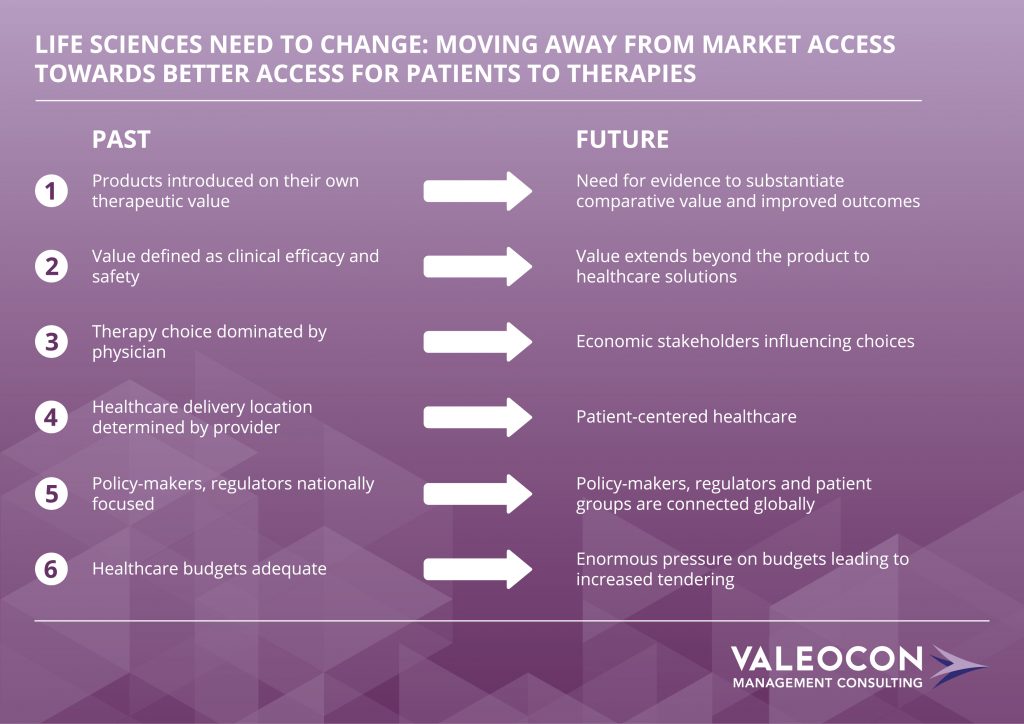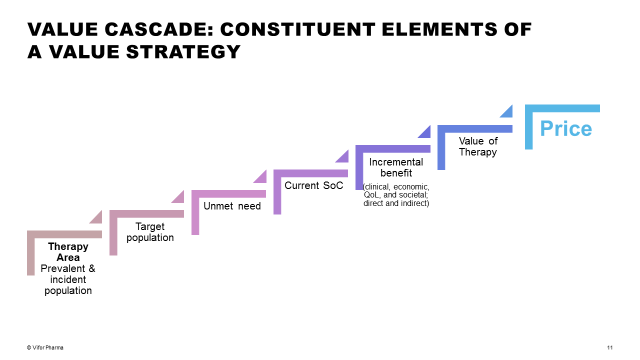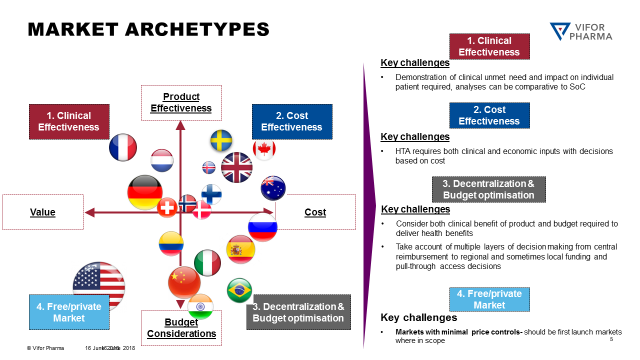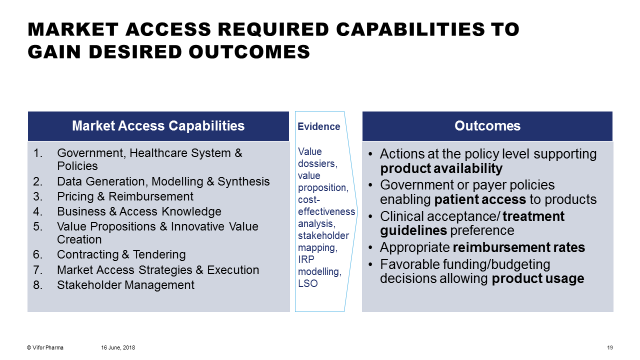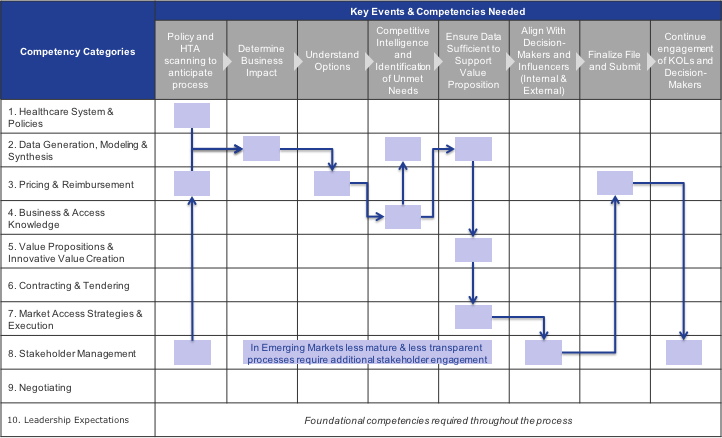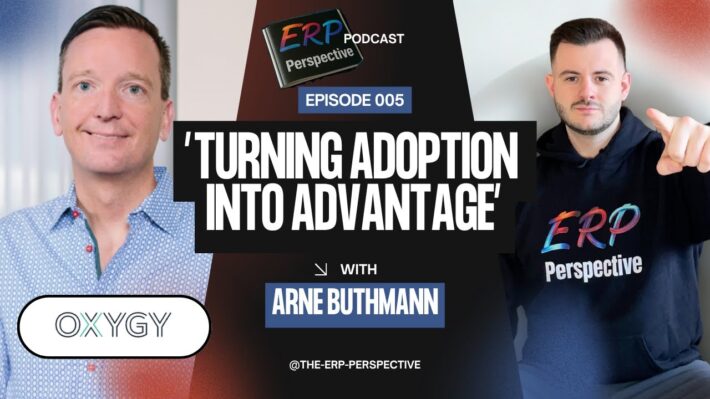- Simultaneously creating value for patients, suppliers of medicines and the healthcare system is a win/win/win proposition.
- To find innovative solutions means reframing the objective from volume to value.
- Listening, understanding the need behind the need, finding common ground and co-designing solutions is the key, collaboration.
- Since patient access is a team sport, having playbooks of how internal and external stakeholders have to collaborate to win is key.
by Peter Vanovertveld & Steve Crom
Vifor Pharma is an agile, €1.2 billion pharma company based in Switzerland that is setting the pace in providing patients access to medicines and therapies they need to improve the quality of their lives. They are doing it in response to the clear trends behind the shift from volume to value in the healthcare industry:
The key is to define value from the perspective of those influencing access decisions, align the organization and roles, and develop the competencies needed to achieve the ultimate goal – “creating a win/win/win solution, that provides value for patients, the company and the healthcare system at large.” (Vanovertfeld & Bertels, November 11, 2015, Market Access Reinvented, PharmaExec).
The main challenge is one of mindset. “Rather than thinking of Market Access as a function, it is a solution-oriented mindset,” says Chris Springer Vifor’s Chief Strategy Officer. The company is developing the right mind-set and capabilities by:
1. Thinking of the Payers as Customers
Healthcare authorities do their best to respond to the increasing needs of an ageing and “empowered” patient population while having to manage limited resources in healthcare systems. Fairness to patients across disease areas is a primary consideration. It is incumbent upon us to understand those pressures and find common ground. For example, a leading supplier of a drug for hemophilia patients probed to understand what is really important to the Irish Health Authorities. While their product works well with 80% of the treatable population, 20% have inhibitors that cause complications requiring expensive counter treatments which are very expensive. Once this surfaced, the supplier came up with an innovative solution: insurance to cover the risk of additional treatment. It led to a 5 year partnership that made the best available medical treatment affordable to more patients by considering the overall impact on the healthcare system.
2. Understanding Who Defines Value
Healthcare professionals, payers, policy makers, drug suppliers and patients all contribute to the definition of value. The considerations are:
- Does the proposed therapy result in better medical outcomes?
- Is the therapy as safe, tolerable as the current standard of care?
- Is this a less expensive substitute treatment?
- Are there additional treatment costs that can be avoided e.g., hospitalization?
- Are there related societal costs and benefits?
Below is a picture of the cascade that ultimately defines value, starting with prevalence of the disease, through unmet need, to incremental benefit leading to the value of the therapy and price.
3. Distinguishing by Market Archetype
A practical way to segment health care markets around the world is by two dimensions: cost to value; and, product effectiveness to budget consideration. This results in four archetypes: clinical effectiveness, cost effectiveness, decentralized budget optimization; and, free/private market that capture the essence of market dynamics in the corresponding countries.
4. Defining Capabilities Required to Achieve Outcomes
The capabilities needed by market to achieve a win/win/win solution will vary by degree; however, fall into categories. Below are the categories developed by Vifor, mapped to the evidence and outcomes they help achieve.
5. Developing playbooks
Securing access for patients to medicines is a team sport. How does one organize operationally to address the needs of patients, payers, providers, policy-makers, and professionals? Vifor uses playbooks that define specific scenarios – such as a Health-Technology Assessment (HTA) for a new product – to test whether the competencies were the right ones and think through how they would be deployed (see below for an example).
Since the needs of payers and other access stakeholders at the local level differ, the scenarios helped test whether global, regional and local roles were properly designed and the interfaces between them sufficiently clear; and highlighted the linkages with other functions critical to access such as R&D, Marketing, and Regulatory. Walking through the scenarios helped clarify how the competencies helped address the needs of the external stakeholders.
6. Building Capabilities Through An Academy
Vifor is a company that values practical approaches, speed and collaborative learning. Based on the principles of co-design, markets are involved with central functions in solving challenges, simultaneously using them as opportunities to learn and create examples from which others can learn and improve. For example, several General Managers in the midst of renegotiating multi-year contracts are taking their people through Negotiation and Influencing skills training which they can immediately apply in practice. These negotiation examples will be used as case studies for others around the Vifor network.
Conclusion
The first step to creating a win/win/win solution is to reframe the problem to be solved around what all stakeholders have in common: enabling more patients to take advantage of therapies that improve the quality of their lives. Walk in the shoes of each stakeholder to understand what they experience, the pressure they face, the choices they have to make and how they define value. The context that stakeholders operate in around the world typically fall into one of four archetypes related to the relative importance of value versus cost; and, clinical effectiveness versus health care budget. The capabilities needs to turn insights into valued outcomes will differ by market. Effective collaboration requires applying those capabilities in the right sequence as a cross-functional team. Take the challenges you face today and use them as learning opportunities, building on the experience to accelerate the learning of others. The pressures caused by the immutable trends in healthcare today can be turned into innovative solutions if framed at the system level and approached with a collaborative mindset and ability.
ABOUT THE AUTHORS
Steve Crom
is the CEO and a founding Partner of Valeocon Management Consulting. He consults on strategy, change leadership, team and organizational effectiveness. He was born in the US, has lived and worked for 25 years in Europe, currently based in Germany and can be reached at steve.crom@oxygyconsulting.com
Peter Vanovertveld
is a Senior Vice President, Head of Global Pricing & Market Access for Vifor Pharma. He Leads the market access department including pricing, HEOR, access, and government affairs in order to optimally complement product and corporate strategy and enable patients across the world to access optimal care. Peter can be reached at peter.vanovertveld@viforpharma.com
[fusion_button link=”https://www.valeocon.com/wp-content/uploads/2018/10/Valeocon_BetterAccessThroughCollaboration.pdf” title=”” target=”_blank” link_attributes=”” alignment=”center” modal=”” hide_on_mobile=”small-visibility,medium-visibility,large-visibility” class=”” id=”” color=”default” button_gradient_top_color=”#3b4251″ button_gradient_bottom_color=”#3b4251″ button_gradient_top_color_hover=”#55a098″ button_gradient_bottom_color_hover=”#55a098″ accent_color=”” accent_hover_color=”” type=”flat” bevel_color=”” border_width=”0px” size=”large” stretch=”default” shape=”” icon=”” icon_position=”left” icon_divider=”no” animation_type=”” animation_direction=”left” animation_speed=”1.0″ animation_offset=””]DOWNLOAD THE PDF[/fusion_button]

